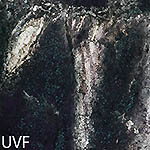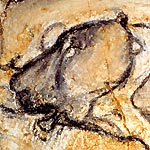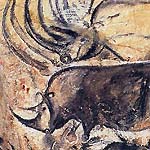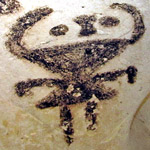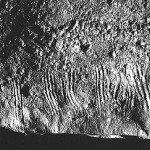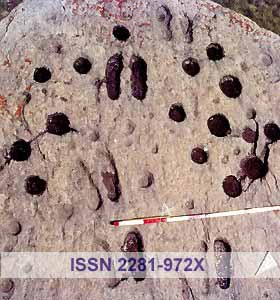 Cantabria posee más de 70 cuevas con arte rupestre
Cantabria posee más de 70 cuevas con arte rupestre
paleolítico, erigiéndose como una de las regiones con mayor
concentración de conjuntos rupestres paleolíticos en Europa.
Su importancia radica en:
– la cantidad de conjuntos,
– la diversidad de técnicas, temática y estilística,
– la concentración de imágenes, antigüedad y continuidad en el tiempo,
– la calidad y excelente estado de conservación.
Archive for Cave art
Cuevas con arte rupestre Paleolítico en Cantabria
Biological activity tracking on cave art sites
[CAA 2015 – session 3C abstract]
Micro-organisms populating caves produce organic acids that damage and dissolve a calcite substratum. This might have been the primary cause of degradation of numerous Palaeolithic paintings in many caves…
by Alexander PAKHUNOV
Read more
Chauvet-Pont d’Arc cave, grand opening!
After only 30 months of work, the opening of the Chauvet-Pont d’Arc cave to the public is scheduled for Saturday 25 April 2015: don’t miss it! It’s the largest cave replica ever built worldwide, ten times bigger than the Lascaux facsimile. All geological and archaeological features, such as paintings and engravings, are reproduced full-size in an underground environment identical to the original one. Visitors’ senses will be stimulated by the same sensations of silence, obscurity, temperature, humidity and acoustics, carefully reproduced.
by Andrea Arcà
La Grotte Chauvet-Pont-d’Arc (EuroPreArt)
[la fiche de EuroPreArt, 2002] La grotte fut découverte le 18 décembre 1994 par trois spéléologues (J.M. Chauvet, E. Brunel-Deschamps, C. Hillaire), et immédiatement authentifiée par les spécialistes (visite de J. Clottes 10 jours après la découverte). La grotte n’a pas connu de visites humaines entre le Paléolithique et sa redécouverte en 1994, ce qui a permis une excellente préservation des ouvres pariétales mais aussi de tout le contexte archéologique.
by Laurence Remacle, Université de Liège
Magura Cave paintings, Bulgarian rock art
Situated in north-western Bulgaria, and managed by the Belogradchik municipality, the Magura cave (Пещера МАГУРА) is, with the Porto Badisco cave (south Italy), the most important European post-Palaeolithic painted cave. Hundreds of dark brown figures are diffused along an astonishing underground Art Gallery: hunting, dancing and mating scenes, bi-triangular female silhouettes, axes, solar symbols… a prehistoric iconographic treasure which definitely deserves a special attention. [Text and photogallery]
by Andrea ARCÀ
Magura cave photogallery
The Bulgarian Magura cave is well known for its impressive prehistoric paintings, scattered along an astonishing and dreamy 240 m long underground diverticulum, for which its Art Gallery is really worth a visit. More than 750 darkish figures have been counted, made with bat guano, smeared or rubbed along the cave walls; on the curvy shaped vaults and niches, white or yellowish “plastered” by the nature, we can recognise dancing, hunting, and mating scenes, and organise the figures into four thematic groups: anthropomorphic, zoomorphic, geometric, and symbolic signs. [Text and photogallery]
by AA
Prehistory popularisation: a de profundis?
Two recently published archaeology books, mainly or partially concerning cave art, show a set of inaccuracies which doesn’t seem acceptable, not only for a specialised scientific level, but also for an educational one. The lack of a review process performed by professional archaeologists demonstrates the weakness in Italy, and not only, of the archaeologist profession, particularly in the prehistoric and rock art fields.
by R.C. de Marinis
Nuevas representaciones de arte paleolítico
En este artículo se presentan nuevas representaciones de arte rupestre paleolítico que han sido halladas recientemente en Extremadura. En dos de los casos se trata de figuras que se añaden a un repertorio iconográfico ya conocido. El tercero de los hallazgos es inédito..
by Hipólito Collado Giraldo
Jean Clottes no Porto
JEAN CLOTTES, francês, é um dos maiores especialistas mundiais de arte rupestre, e em particular de arte paleolítica, Conservador geral do Património, está encarregado da direcção da equipa que estuda a gruta Chauvet – uma das mais importantes descobertas dos anos 90 neste âmbito.
Bhimbetka cave paintings (India)
I am sending some photographs of pre-historic cave paintings at Bhimbetka,Madhya Pradesh, India (taken by me) which you may like to publish in TRACCE bulletin. I shall be thankful if my name is mentioned as contributor.
by Sarbanidas Roy
Grotte Chauvet Archaeologically Dated
TRACCE no. 12 – by Christian Züchner
The Grotte Chauvet was discovered at Christmas 1994. A beautiful picture book came out only a few months later (Chauvet et al. 1995). It has been the main source of our knowledge and discussion up to now.
Bronze Age sculpted caves in the Périgord
TRACCE no. 9 – by Norbert Aujoulat – Christian Chevillot
2nd International Congress of Rupestrian Archaeology
2-5 October 1997 DARFO BOARIO TERME
Bronze Age sculpted caves in the Périgord (Dordogne – France)
The Périgord has been famous since the XIX c. for its wealth of caves painted and sculpted in the Palaeolithic era…
